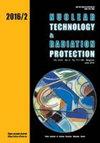Indoor radon monitoring in various ventilation degree in some schools of Duhok City, Iraq
IF 0.7
4区 工程技术
Q3 NUCLEAR SCIENCE & TECHNOLOGY
引用次数: 0
Abstract
Radon is a radioactive noble gas, recognized as a carcinogenic agent, being affected by degree of ventilation. The aim of this preliminary study was to determine the concentration of indoor radon gas in schools, to estimate the main factors affecting their radon concentration levels and to analyze the effective dose received by students in Duhok schools. Therefore, the concentrations of radon were measured in 28 classrooms, from 13 schools located in Duhok city, using both RAD7 and Corentium monitor, from January 15-30, 2021. In all schools indoor radon was measured in four different scenarios of closed, natural and mechanical ventilation then, radon reduction rate between each case was calculated. In addition to that, exposure to annual effective dose of radon, for each different degree of ventilation, was evaluated. Furthermore, effects of building floors were studied. Results showed that maximum radon concentration, 121 Bqm-3, was recorded in closed ventilation, while minimum, 15 Bqm-3, was recorded in mechanical ventilation. Radon reduction rate in a mechanical ventilation is relatively large 81%. Also, results demonstrate that indoor radon levels at first floor, in all schools under study, were considerably greater than those at second and third floor (p < 0.05). The annual effective dose of all studied schools at 4 different cases of ventilation were found less than the worldwide average radiation dose of 3-10 mSv. So, it is not required to take any action to minimize the level of radon in schools under study.伊拉克杜胡克市部分学校不同通风程度室内氡监测
氡是一种放射性惰性气体,是公认的致癌物质,受通风程度的影响。这项初步研究的目的是确定学校室内氡气的浓度,估计影响其氡浓度水平的主要因素,并分析杜胡克学校学生接受的有效剂量。因此,从2021年1月15日至30日,使用RAD7和Corentium监测仪在杜霍克市13所学校的28间教室中测量了氡浓度。对所有学校室内氡进行了封闭通风、自然通风和机械通风四种不同情况下的测量,并计算了每种情况下的氡降低率。此外,还对不同通风程度的氡年有效暴露剂量进行了评价。此外,还研究了建筑楼层的影响。结果表明,密闭通风时氡浓度最高,为121 Bqm-3,机械通风时氡浓度最低,为15 Bqm-3。机械通风的氡消减率较大,达81%。结果还表明,在所有研究学校中,一楼的室内氡水平明显高于二楼和三楼(p < 0.05)。所有研究学校在4种不同通风情况下的年有效剂量均低于世界平均辐射剂量3-10毫西弗。因此,不需要采取任何行动来降低所研究学校的氡水平。
本文章由计算机程序翻译,如有差异,请以英文原文为准。
求助全文
约1分钟内获得全文
求助全文
来源期刊

Nuclear Technology & Radiation Protection
NUCLEAR SCIENCE & TECHNOLOGY-
CiteScore
2.00
自引率
41.70%
发文量
10
审稿时长
6-12 weeks
期刊介绍:
Nuclear Technology & Radiation Protection is an international scientific journal covering the wide range of disciplines involved in nuclear science and technology as well as in the field of radiation protection. The journal is open for scientific papers, short papers, review articles, and technical papers dealing with nuclear power, research reactors, accelerators, nuclear materials, waste management, radiation measurements, and environmental problems. However, basic reactor physics and design, particle and radiation transport theory, and development of numerical methods and codes will also be important aspects of the editorial policy.
 求助内容:
求助内容: 应助结果提醒方式:
应助结果提醒方式:


